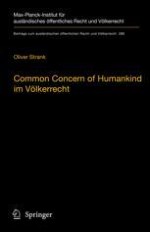2019 | OriginalPaper | Buchkapitel
XV. Die erga omnes-Wirkung des common concern of humankind-Prinzips (Sekundärebene)
verfasst von : Oliver Strank
Erschienen in: Common Concern of Humankind im Völkerrecht
Verlag: Springer Berlin Heidelberg
Aktivieren Sie unsere intelligente Suche, um passende Fachinhalte oder Patente zu finden.
Wählen Sie Textabschnitte aus um mit Künstlicher Intelligenz passenden Patente zu finden. powered by
Markieren Sie Textabschnitte, um KI-gestützt weitere passende Inhalte zu finden. powered by
